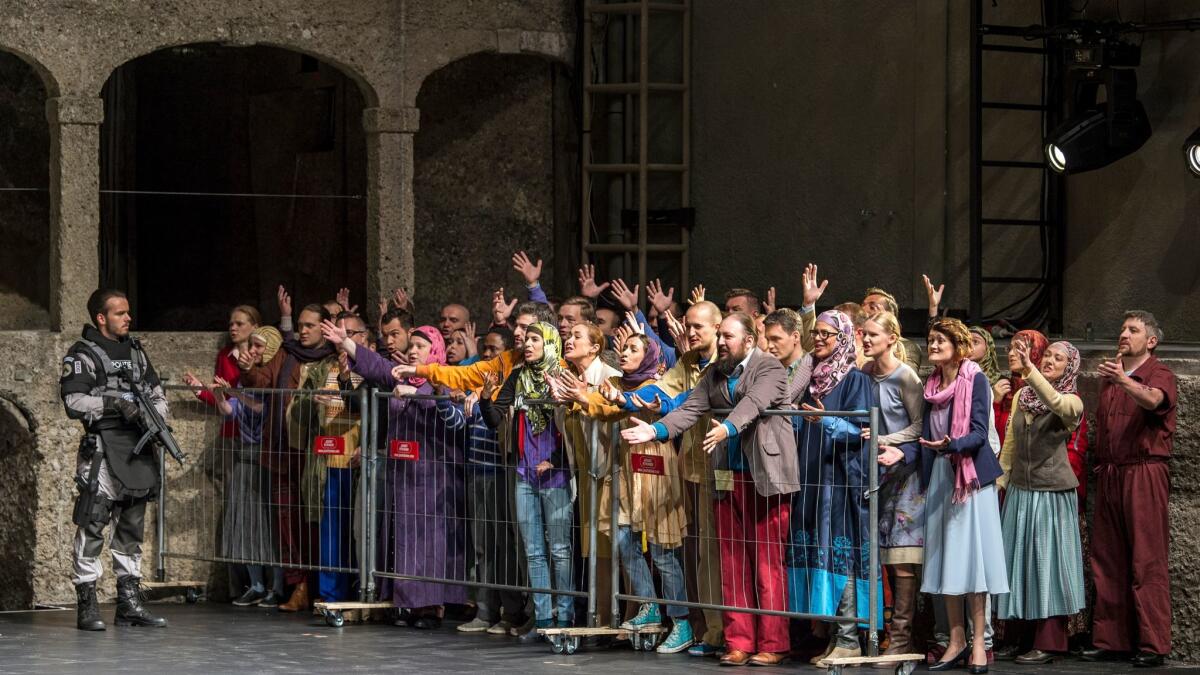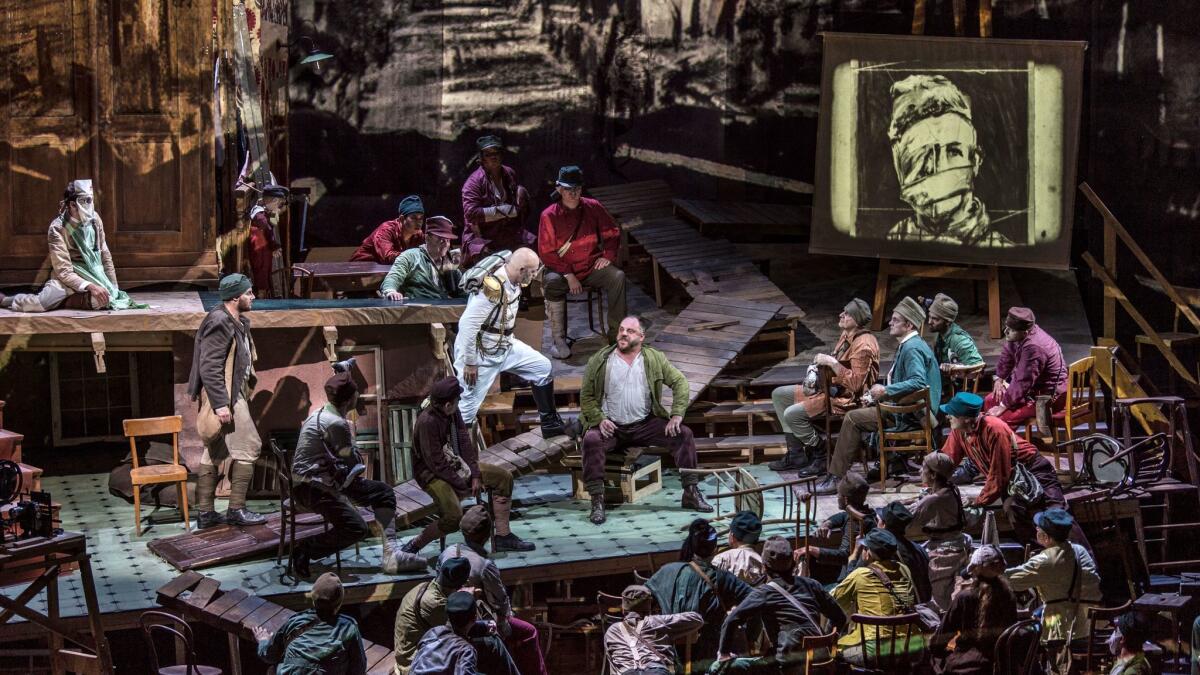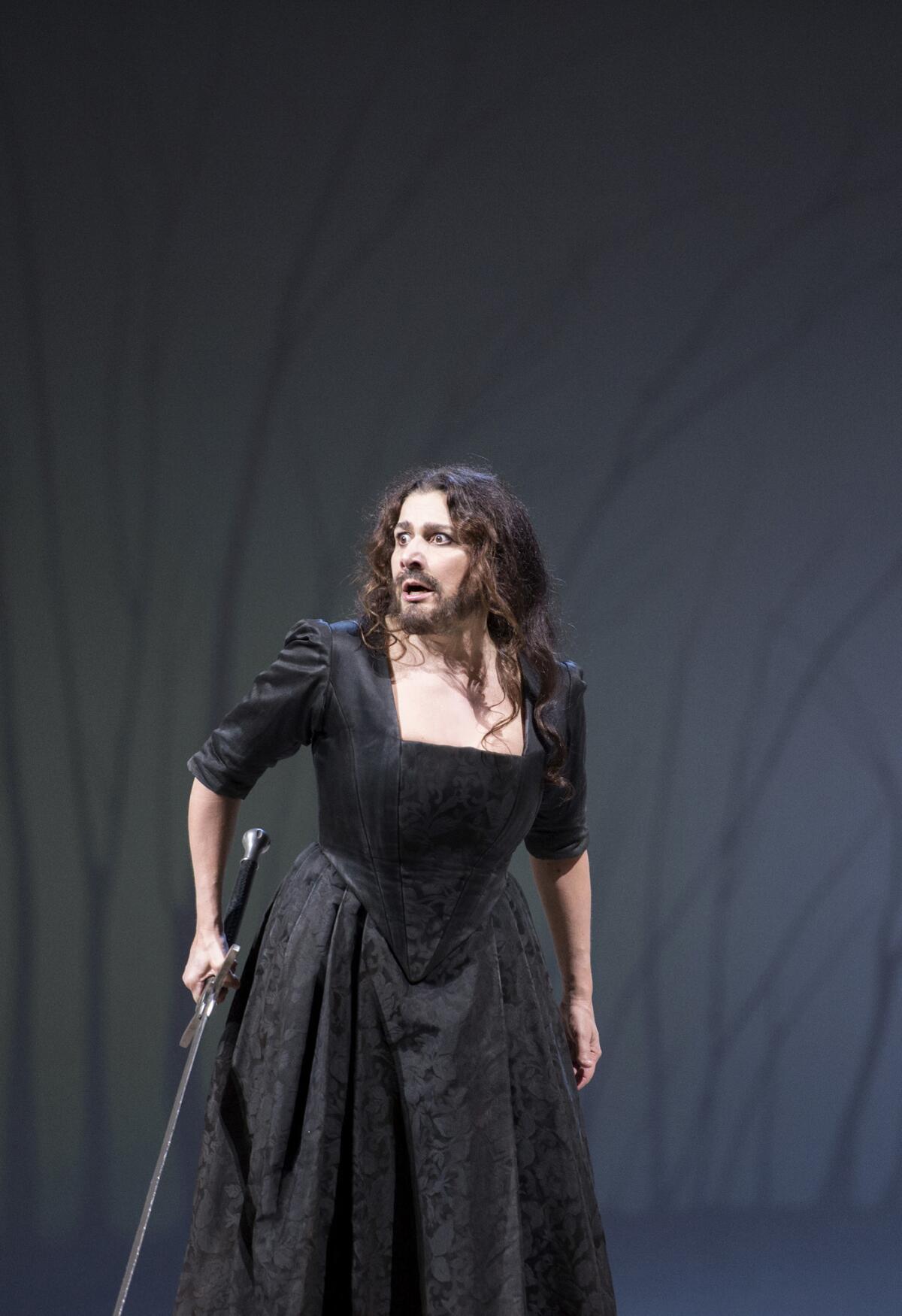Why do music festivals matter? For an answer, America, look to Salzburg
- Share via
The Salzburg Festival is back. And it’s time for Los Angeles to pay attention. America lacks a great international music and theater festival. The Lincoln Center Festival, lackluster in recent times and its future uncertain, is the closest. The Music Center is known to be cooking something up.
But right now the grandest classical music gathering of opera, orchestral concerts, recitals, young artist projects, opera camps for children and new music series remains in Austria. It has been around for 97 years, and glamorous, big-name performers continue to flock to Mozart’s birthplace at the scenic foot of the Austrian Alps. Music bigwigs wheel and deal at restaurants facing a festival theater built into the side of a mountain. They pay whatever it takes to see and be seen, parading in finery that ranges from black tie to the occasional formal lederhosen.
Politicians, left and right, come for uncontroversial attention (and a few for the music). While doting on stylish new French President Emmanuel Macron here in late August, Austrian television also dug out 1970s footage of President Gerald R. Ford arriving for the festival and promptly falling down the stairs as he deplaned from Air Force One at the Salzburg Airport.
The festival’s glory days, when the legendary likes of Arturo Toscanini held court, were diminished during the Nazi era. The postwar festival, rebuilt by Herbert von Karajan, reached a point of near-suffocating grandeur in the 1980s, then entered a new era when a renowned opera provocateur, Gerard Mortier, took over in 1992.
With a gift for studied outrage, Mortier immediately pushed aside the refined Vienna Philharmonic and superstar conductors for the brash
That pianist, Markus Hinterhäuser, became the director of the festival this summer, following relatively uninspiring post-Mortier seasons. Now the festival’s budget, which had been around $80 million before it was cut a couple of years ago, has risen again to $75 million.
Hinterhäuser, whose rumpled style serves in delicious contrast to previous bespoke-suited impresarios, has retrieved something of the late Mortier’s spirit. The Angeleno angle no longer exists. (The day after every festival ended, Mortier used to fly to LAX, visit Freeman and then drive up Highway 1 to Big Sur to decompress.) But Hinterhäuser, who will finally make his Southern California debut performing at the Ojai Festival next summer, has turned Salzburg into a model festival from which we can learn a lot.
Foremost among Hinterhäuser’s innovations is taking on big themes. As the most attention-getting of the nearly 200 festival events, the six major opera productions (five of them new) all considered the issue of political power. That’s a bold notion for this all-powerful festival that relies on political goodwill for funding as well as powerful corporate support.
It was hard to miss the symbolism for the Hinterhäuser’s choice of the summer’s first opera production, Mozart’s “La Clemenza di Tito.” This was the same opera that 25 years earlier Mortier employed to lay down his gantlet with a defiantly sexual production about the Roman emperor who shows moderation in the face of a populist uprising. Traditional Salzburg was shocked. The conductor,
The new Salzburg “Clemenza” brought back Sellars for the first time since Mortier’s tenure. It was politically pointed and daring musically, reimagining the libretto as reflecting a Europe being redrawn politically and racially by the arrival of Middle Eastern emigrants and by terrorism.
For Sellars the solution has to be as much spiritual as political, and that too happened to be one of Hinterhäuser’s themes for a concert series of ancient and modern music meant to remind us of the importance of sacred spaces.

Consequently, Sellars and conductor Teordor Currentzis added their own politically indispensable sacred spaces to “Clemenza” by including excerpts from Mozart’s C-Minor Mass and otherwise doing musical surgery on the opera score. And wouldn’t you know it, Muti was overheard in Salzburg once again voicing objection.
Muti had returned to Salzburg because Hinterhäuser talked him into conducting a new production of “Aida.” This time, the Italian conductor could assert his own musical and political artistic approach.
After a peacekeeping concert mission to Tehran in early July, Muti told the Financial Times that music that “brings a message of love and friendship can do more than diplomats.” Not coincidentally, Hinterhäuser had engaged the Iranian feminist visual artist Shirin Neshat to stage “Aida.” That helped to interest Muti in the project. Salzburg’s aristocratic audience is eager for starry singers, so the production also featured Anna Netrebko singing the title role for the first time.
A video artist and photographer capable of creating unforgettable imagery about religious overreach, Neshat produced a visual spectacle in which ancient Egyptian priests became unbending imams. She used the veil for emblematic effect. She tolerated neither elephants nor marching in the famous Triumphant March — just the scary stationary presence of massed religious leaders.
With the Vienna Philharmonic in the pit, Muti underscored Neshat’s vision with static awesomeness. But Muti showed little command over the solo singers. Netrebko was meant to be an Aida as outsider, and though she is a talented actor, left to her own devices she seemed like the ultimate opera insider, emoting cloyingly to the pleasure of her fan base. Nevertheless, she conveyed more personality and vocal warmth than either
The conflict here was essentially the opera world against the art world. Art won, and its victory was significant. Another of Hinterhäuser’s important priorities is to make Salzburg artistically relevant.
This became particularly evident when I broke up a week in Salzburg with a brief journey to Kassel, Germany, where the art exhibition documenta is held every six years. Like the Salzburg Festival, documenta takes over a whole city and draws tens thousands of visitors.
More important, documenta is paying as much attention to contemporary music as Salzburg is to contemporary art. This year’s documenta had listening spaces, concerts and a radio program streamed online. Dozens of commissions were for sound works by long-established composers such as Alvin Curran, visual artists and the multiverse of those who cross over from one field to the other, particularly in experimental pop music.
There was something to hear often where you least expected it. Ben Patterson’s “When Elephants Fight, It Is the Frogs That Suffer,” a 24-channel installation in and around a pond in Karlsaue Park, was the entrancing last major work by the Fluxus composer and bass player. It sounded like heavenly croaking from the beyond.
For the first time documenta was divided between two cities, Kassel and Athens, and I’m told that in Greece the music and sound works were even more prevalent.
Six years earlier, South African artist William Kentridge’s installation, “Refuse the Time,” was one of the most popular works at documenta. I missed it then because of the three-hour wait. But I saw it in Salzburg this summer at the Museum der Moderne as part of a Kentridge retrospective mounted in conjunction with the artist’s new festival production of “Wozzeck.”
Again, against considerable odds, art won. Kentridge created an all-consuming stage picture, with video, lighting and extravagant costumes and drawings depicting the horror of the First World War. Those visuals swamped the singers, including the estimable Matthias Goerne. Sonically they were further overpowered by a resplendent Vienna Philharmonic in the pit, meticulously conducted by Vladimir Jurowski.

Salzburg on steroids certainly does take your breath away, as this production (which will go on to the Metropolitan Opera in New York) certainly did.
The other two opera productions I saw in Salzburg were more about power than art. Despite a gritty staging by German director Andreas Kriegenburg in what appeared a grimy Soviet apartment block, Shostakovich’s “Lady Macbeth of the Mtsensk District” was domesticated by Mariss Janson’s grandiose symphonic conducting. But the performance boasted an impressive cast, especially a star-is-born debut of a young soprano, Evgenia Muraveva, who replaced an indisposed Nina Stemme in the title role.
Hinterhäuser was not responsible for Handel’s “Ariodante,” starring Cecilia Bartoli and directed by Christof Loy. The mezzo superstar runs her own festival in Salzburg in June, and she is invited to repeat her one major production at the big summer festival. But you have to wonder whether given the standards now operating at Salzburg, she’s begun watching her step, not wanting to replicate something as alarmingly awful as her “West Side Story” last year.

It’s a weird “Ariodante.” Bartoli starts out as a woman singing a man’s role. Midway through, she has become a woman with a beard, which she ultimately loses. Her fiancé hardly seems to notice, and they go off hand in hand. The singing was sensational, and what seemed at first as annoyingly a brazen stage gimmick wound up as a touchingly different take on power in the modern world.
Big government and big business are not going to give L.A. — or anywhere else in America — $75 million for a festival, especially one that questions a lot of what the politicos and their underwriters are up to. But it is worth remembering the role L.A. played in helping to transform Salzburg.
Salzburg maintains that the $75 million spent on the festival generates four times as much in revenue for the city. The final report of this summer’s six-week festival, which ended Wednesday, said 97% of all tickets were sold. Attendance was 261,500, more than double the capacity of the
We will have a couple of Salzburgian echoes in the fall season. In November, the Center for the Art of Performance at UCLA presents Kentridge’s “Refuse the Hour,” his operatic version of “Refuse the Time.” This week, tenor Brandon Jovanovich, outstanding in “Lady Macbeth,” stars in Los Angeles Opera’s “Carmen.” Meanwhile, civic and arts leaders would do well to set up meetings with Hinterhäuser when he comes in June for the Ojai festival. See whether the L.A.-Salzburg connection might, in some way, come back for real.
The biggest entertainment stories
Get our big stories about Hollywood, film, television, music, arts, culture and more right in your inbox as soon as they publish.
You may occasionally receive promotional content from the Los Angeles Times.








